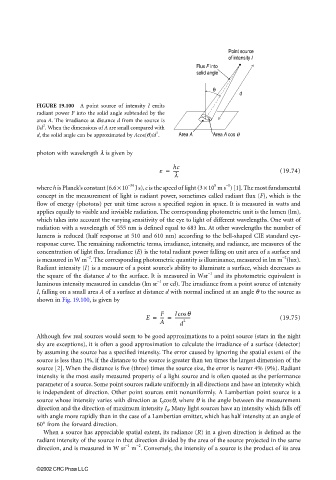Page 498 - The Mechatronics Handbook
P. 498
0066_frame_C19 Page 120 Wednesday, January 9, 2002 5:32 PM
FIGURE 19.100 A point source of intensity I emits
radiant power F into the solid angle subtended by the
area A. The irradiance at distance d from the source is
2
I/d . When the dimensions of A are small compared with
d, the solid angle can be approximated by Acos(θ)/d . 2
photon with wavelength λ is given by
= hc (19.74)
-----
λ
−34 8 −1
where h is Planck’s constant (6.6 × 10 J s), c is the speed of light (3 × 10 m s ) [1]. The most fundamental
concept in the measurement of light is radiant power, sometimes called radiant flux (F), which is the
flow of energy (photons) per unit time across a specified region in space. It is measured in watts and
applies equally to visible and invisible radiation. The corresponding photometric unit is the lumen (lm),
which takes into account the varying sensitivity of the eye to light of different wavelengths. One watt of
radiation with a wavelength of 555 nm is defined equal to 683 lm. At other wavelengths the number of
lumens is reduced (half response at 510 and 610 nm) according to the bell-shaped CIE standard eye-
response curve. The remaining radiometric terms, irradiance, intensity, and radiance, are measures of the
concentration of light flux. Irradiance (E) is the total radiant power falling on unit area of a surface and
−2 −2
is measured in W m . The corresponding photometric quantity is illuminance, measured in lm m (lux).
Radiant intensity (I) is a measure of a point source’s ability to illuminate a surface, which decreases as
−1
the square of the distance d to the surface. It is measured in Wsr and its photometric equivalent is
−1
luminous intensity measured in candelas (lm sr or cd). The irradiance from a point source of intensity
I, falling on a small area A of a surface at distance d with normal inclined at an angle θ to the source as
shown in Fig. 19.100, is given by
F
E = --- = Icos θ (19.75)
--------------
A d 2
Although few real sources would seem to be good approximations to a point source (stars in the night
sky are exceptions), it is often a good approximation to calculate the irradiance of a surface (detector)
by assuming the source has a specified intensity. The error caused by ignoring the spatial extent of the
source is less than 1%, if the distance to the source is greater than ten times the largest dimension of the
source [2]. When the distance is five (three) times the source size, the error is nearer 4% (9%). Radiant
intensity is the most easily measured property of a light source and is often quoted as the performance
parameter of a source. Some point sources radiate uniformly in all directions and have an intensity which
is independent of direction. Other point sources emit nonuniformly. A Lambertian point source is a
source whose intensity varies with direction as I 0 cosθ, where θ is the angle between the measurement
direction and the direction of maximum intensity I 0 . Many light sources have an intensity which falls off
with angle more rapidly than in the case of a Lambertian emitter, which has half intensity at an angle of
60° from the forward direction.
When a source has appreciable spatial extent, its radiance (R) in a given direction is defined as the
radiant intensity of the source in that direction divided by the area of the source projected in the same
−1
−2
direction, and is measured in W sr m . Conversely, the intensity of a source is the product of its area
©2002 CRC Press LLC

